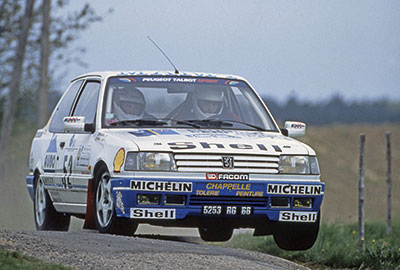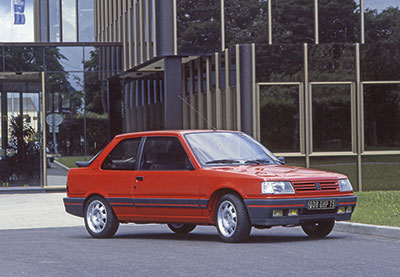-
MenuBack
-
COLLECTIONS
-
-
24h00 Le Mans
-
Alpine A110 1600S
-
Lancia 037
-
-
-
FULL KIT
-
-
FULL KIT
-
-
- ACCESSORIES
- Australian
- MAQMADON
-
Assembly guides
-
-
Blog Ixo
-
- FAQ
The Peugeot 309 GTI
Unveiled at the Paris Motor Show in October 1985, the 309 was presented as an enlarged 205, from which it also took on several bodywork elements, due to production savings. Initially available with a five-door body, the 309 was offered in a three-door version from February 1987. The idea of affixing the magic GTI logo and equipping it with the mechanics of the sportiest 205 was not long in coming.
When fans of small bombs became fathers of families, the size of the 205 GTI was no longer enough. The arrival of the 309 GTI, with the same performance and advantages as its younger sibling, was therefore greeted with enthusiasm. Until then, it was the GT with its 105 hp engine that played the role of locomotive of the 309 range, but its chassis, common to the other versions, did not allow for a really efficient sporty driving. By taking over the transmission, suspension, front axle and braking from the 205 GTI, the 309 of the same name will offer the stable and balanced behaviour of a real sports car while keeping the air of a family car!

From 1991 to 1993, Peugeot Talbot Sport organised the Volant Peugeot Shell, a promotional formula reserved for 309 GTI 16 Group N drivers competing in the French Rally Championship.
© IXO Collections SAS - Tous droits réservés. Crédits photo © Peugeot
A Simca-Talbot project
After the takeover of the European branch of the American manufacturer Chrysler by PSA in August 1978, all the former subsidiaries took the name Talbot-Chrysler and Talbot-Simca for the French network. The succession of names in a short time for the same model (Chrysler-Simca, Talbot-Simca, then Talbot alone from 1981) confuses customers and sales of old models such as the Horizon collapse, while the new top-of-the-range saloon Tagora is a commercial failure. The brand began to experience serious problems, accentuated by the fact that the combined Talbot and Peugeot ranges lacked homogeneity. In 1983, the small 205 was released, which brought Peugeot out of the financial abyss. The manufacturer from Sochaux then took advantage of this to get rid of Talbot for good the following year. The C28 project, which was supposed to replace the Horizon and on which Talbot's design office had been working since 1982, was therefore born under the auspices of Peugeot and the name 309. However, it was not the usual team from the Peugeot design office that continued the development of the C28 prototype. It was in fact entrusted to the advanced styling centre under the direction of Gérard Welter.

The Peugeot 309 GTI has an undeniable family resemblance with the 205 GTI 1.9, from which it takes its 15-inch alloy wheels.
© IXO Collections SAS - Tous droits réservés. Crédits photo © Peugeot
Cousin to the 205
The C28 was to be inserted into the Peugeot range between the 205 and the 305, the latter being replaced by the 405 in 1987. This model was therefore to be a compact saloon and from the outset Alain Pottier, the project manager, was faced with the dilemma of choosing between a hatchback body like the small 205 or a three-box like the 305. The designer's subtlety consisted in defining a "two and a half body" saloon body, the length of which (4.05 m) was between the 3.70 m of the 205 and the 4.26 m of the 305. Another requirement, more economical this time, was that the 309 had to use as many structural elements as possible from the 205, while remaining in the spirit of the new Peugeot style. Thus, the first generation 309, which was launched in October 1985, took over the doors of the 205 and the surrounding structures such as the hinges, the handles and the window lift systems. The 309 did not always meet with unanimous approval for its lines and was seriously restyled in 1989. The entire 309 range, including the GTI version, was replaced by the 306 from July 1993.

François Delecour (right) and his teammate Christian Gilbert competed in the French Rally Championship in 1989 and 1990 with a 309 GTI entered by Peugeot France Dealers.
© IXO Collections SAS - Tous droits réservés. Crédits photo © Peugeot
A lion under the bonnet!
Following the example of the previous 205 GTI, Peugeot decided to produce a more muscular version of its 309, barely two years after its launch. The engine chosen to equip this new 309 GTI was the four-cylinder XU9-JA (D6B) of 1,905 cm3 developing 130 bhp at 6,000 rpm, allowing a top speed of 206 km/h and the 1,000 m standing start in less than 30 seconds! Two years later, in 1990, the 309 GTI Phase 2 inherited the brilliant 1,905 cm3 16-valve engine from the 405 MI 16. Power rose to 160 bhp at 5,600 rpm and the top speed to 220 km/h. Externally, it differs from the 130 hp version only in details such as the black bumper and side strips instead of the previous red ones. An efficient sports car, the 309 GTI was chosen to replace the 505 in the Peugeot Trophy from 1988. This one-make competition organised on the main French circuits was won successively by André Bourdon in 1988 and 1989, then Jean Lallier the following two seasons. Regularly, national motor sport figures such as Jean-Pierre Beltoise, Jean-Pierre Jabouille, Jacques Laffite or Jean-Louis Schlesser were invited to compete in some of the events of this championship.

With its exceptional sporting behaviour, the Peugeot 309 GTI 16S launched in 1990 remains an absolute reference among all GTIs.
© IXO Collections SAS - Tous droits réservés. Crédits photo © Peugeot
Share this post





 Français
Français Anglais
Anglais Allemand
Allemand Espagnol
Espagnol Italien
Italien Portugal
Portugal